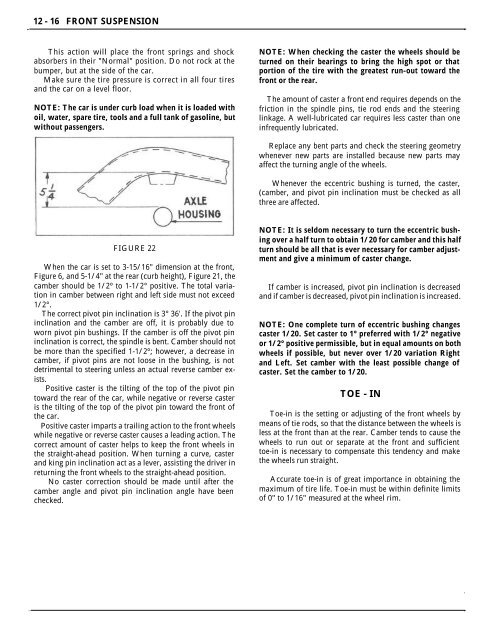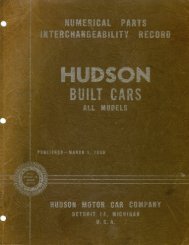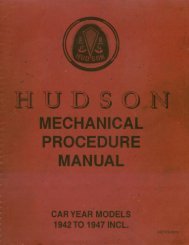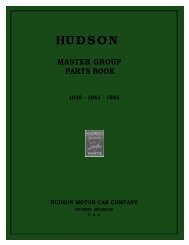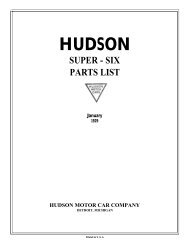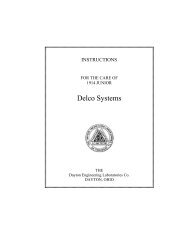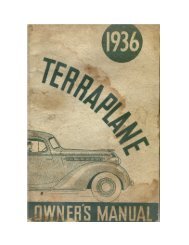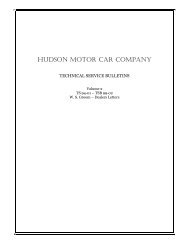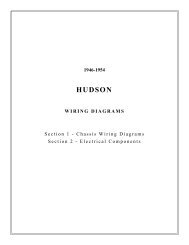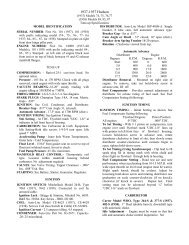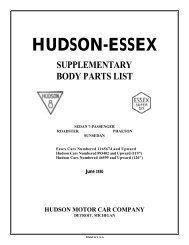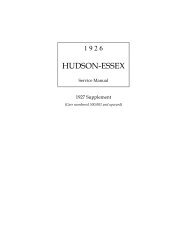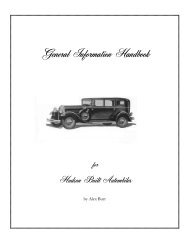1948-1952 Shop Service Manual - - Hudson-Essex-Terraplane Club
1948-1952 Shop Service Manual - - Hudson-Essex-Terraplane Club
1948-1952 Shop Service Manual - - Hudson-Essex-Terraplane Club
Create successful ePaper yourself
Turn your PDF publications into a flip-book with our unique Google optimized e-Paper software.
12 - 16 FRONT SUSPENSION<br />
This action will place the front springs and shock<br />
absorbers in their "Normal" position. Do not rock at the<br />
bumper, but at the side of the car.<br />
Make sure the tire pressure is correct in all four tires<br />
and the car on a level floor.<br />
NOTE: The car is under curb load when it is loaded with<br />
oil, water, spare tire, tools and a full tank of gasoline, but<br />
without passengers.<br />
NOTE: When checking the caster the wheels should be<br />
turned on their bearings to bring the high spot or that<br />
portion of the tire with the greatest run-out toward the<br />
front or the rear.<br />
The amount of caster a front end requires depends on the<br />
friction in the spindle pins, tie rod ends and the steering<br />
linkage. A well-lubricated car requires less caster than one<br />
infrequently lubricated.<br />
Replace any bent parts and check the steering geometry<br />
whenever new parts are installed because new parts may<br />
affect the turning angle of the wheels.<br />
Whenever the eccentric bushing is turned, the caster,<br />
(camber, and pivot pin inclination must be checked as all<br />
three are affected.<br />
FIGURE 22<br />
When the car is set to 3-15/16" dimension at the front,<br />
Figure 6, and 5-1/4" at the rear (curb height), Figure 21, the<br />
camber should be 1/2º to 1-1/2° positive. The total variation<br />
in camber between right and left side must not exceed<br />
1/2°.<br />
The correct pivot pin inclination is 3° 36'. If the pivot pin<br />
inclination and the camber are off, it is probably due to<br />
worn pivot pin bushings. If the camber is off the pivot pin<br />
inclination is correct, the spindle is bent. Camber should not<br />
be more than the specified 1-1/2º; however, a decrease in<br />
camber, if pivot pins are not loose in the bushing, is not<br />
detrimental to steering unless an actual reverse camber exists.<br />
Positive caster is the tilting of the top of the pivot pin<br />
toward the rear of the car, while negative or reverse caster<br />
is the tilting of the top of the pivot pin toward the front of<br />
the car.<br />
Positive caster imparts a trailing action to the front wheels<br />
while negative or reverse caster causes a leading action. The<br />
correct amount of caster helps to keep the front wheels in<br />
the straight-ahead position. When turning a curve, caster<br />
and king pin inclination act as a lever, assisting the driver in<br />
returning the front wheels to the straight-ahead position.<br />
No caster correction should be made until after the<br />
camber angle and pivot pin inclination angle have been<br />
checked.<br />
NOTE: It is seldom necessary to turn the eccentric bushing<br />
over a half turn to obtain 1/20 for camber and this half<br />
turn should be all that is ever necessary for camber adjustment<br />
and give a minimum of caster change.<br />
If camber is increased, pivot pin inclination is decreased<br />
and if camber is decreased, pivot pin inclination is increased.<br />
NOTE: One complete turn of eccentric bushing changes<br />
caster 1/20. Set caster to 1° preferred with 1/2° negative<br />
or 1/2° positive permissible, but in equal amounts on both<br />
wheels if possible, but never over 1/20 variation Right<br />
and Left. Set camber with the least possible change of<br />
caster. Set the camber to 1/20.<br />
TOE - IN<br />
Toe-in is the setting or adjusting of the front wheels by<br />
means of tie rods, so that the distance between the wheels is<br />
less at the front than at the rear. Camber tends to cause the<br />
wheels to run out or separate at the front and sufficient<br />
toe-in is necessary to compensate this tendency and make<br />
the wheels run straight.<br />
Accurate toe-in is of great importance in obtaining the<br />
maximum of tire life. Toe-in must be within definite limits<br />
of 0" to 1/16" measured at the wheel rim.


